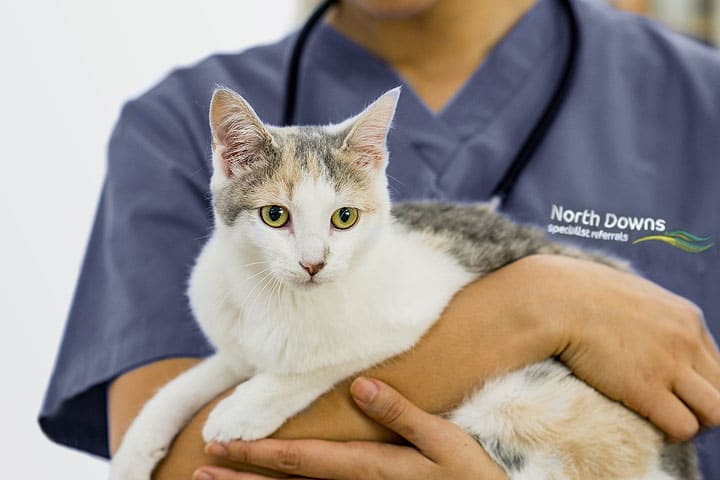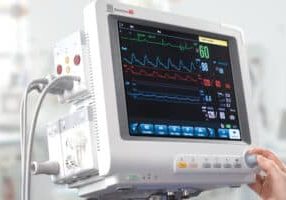
Myocardial disease is common in cats with a prevalence of around 15% of the general population, that increases up to approximately 30% in older cats.
Hypertrophic cardiomyopathy is the most common form of myocardial disease but other, less common forms of myocardial disease, including restrictive cardiomyopathy (RCM), dilated cardiomyopathy (DCM) and arrhythmogenic cardiomyopathy (ARVC) are important to recognise.
How do cats with subclinical myocardial disease present?
Identifying cats with subclinical myocardial disease can be challenging. Unlike dogs with mitral valve disease for example, the detection of a heart murmur is not a reliable screening tool in cats. Although most cats with HCM have an audible heart murmur, up to 30% of cats with non-obstructive forms of disease do not have a murmur. Murmurs can also be variable (dynamic) making their detection and characterisation inconsistent. On the other hand, murmurs are common in healthy cats. The detection of other abnormalities on auscultation such as gallop sounds or arrhythmia is very important as these are rare in healthy cats and should prompt further investigations. A normal physical examination does not therefore rule out subclinical disease and sudden onset of CHF, ATE or sudden death may occur without warning signs.
Although in the majority of cats, myocardial disease remains subclinical throughout their lives, about a third of affected cats will develop clinical signs of congestive heart failure (CHF), arterial thromboembolism (ATE) or both. Sudden death is uncommon but can occur without previous signs. It is therefore of high importance to identify risk factors that can help distinguish cats that have a favourable outcome from cats at risk of developing clinical signs or cardiac death.
Younger, asymptomatic cats are more likely to have a favourable prognosis whereas the presence of a gallop sound or arrhythmia on physical examination is associated with increased risk of complications.
Echocardiography plays an important role in disease staging as it allows us to identify risk factors associated with increased risk for CHF or ATE:
- Moderate to severe left atrial enlargement
- Decreased left atrial fractional shortening
- Extreme left ventricle hypertrophy
- Decreased left ventricle function
- Spontaneous echo-contrast (‘smoke’) or intracardiac thrombi
- Segmental wall thinning with hypokinesis
- Restrictive diastolic functional class
What treatment should be considered for cats with subclinical myocardial disease?
Treatment of cats with subclinical myocardial disease is limited as randomised clinical trials showing effective treatment to delay or prevent life-threatening complications are lacking. However, owner education to recognise early signs (e.g. resting respiratory rate) and prophylactic treatment for ATE are two examples of interventions that can reduce the risk of life-threatening complications.
Recently published guidelines for the classification, diagnosis, and management of cardiomyopathies in cats, provide a staging system for cardiomyopathy that helps identifying cats at low and high risk of developing life-threatening complications.
Top Tips for Use In Practice
- Suspect feline myocardial disease if there is:
- Heart murmur
- Arrhythmia
- Gallop
- High NT-proBNP
- Familial history of HCM
- Do not rule out myocardial disease based on a normal physical examination
- Screening for myocardial disease should be considered in apparently healthy older cats before:
- Anaesthesia
- Treatment with IV fluids
- Use of extended-release corticosteroids
- Echocardiography is the most reliable diagnostic test to identify subclinical myocardial disease:
- Focused point-of-care echocardiography by trained operators can be useful
- Standard echocardiography should follow for phenotype characterisation, prognosis and treatment considerations
- Cardiac biomarkers (NT-proBNP) can be useful if echocardiography is not available but the clinician should be aware of its limitations.
References and suggested reading:
Luis Fuentes V, Abbott J, Chetboul V, et al. ACVIM consensus statement guidelines for the classification, diagnosis, and management of cardiomyopathies in cats. J Vet Intern Med. 2020;34(3):1062-1077. doi:10.1111/jvim.15745
Fox PR, Keene BW, Lamb K, et al. International collaborative study to assess cardiovascular risk and evaluate long-term health in cats with preclinical hypertrophic cardiomyopathy and apparently healthy cats: The REVEAL Study [published correction appears in J Vet Intern Med. 2018 Nov;32(6):2310]. J Vet Intern Med. 2018;32(3):930-943. doi:10.1111/jvim.15122.
Case Advice or Arranging a Referral
If you are a veterinary professional and would like to discuss a case with one of our team, or require pre-referral advice about a patient, please call 01883 741449. Alternatively, to refer a case, please use the online referral form
About The Discipline
Cardiology

Need case advice or have any questions?
If you have any questions or would like advice on a case please call our dedicated vet line on 01883 741449 and ask to speak to one of our Cardiology team.
Advice is freely available, even if the case cannot be referred.